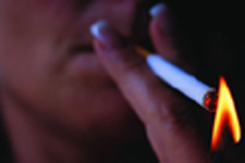
Secondhand smoke, also known as Environmental Tobacco Smoke (ETS), consists of exhaled smoke from smokers and side stream smoke from the burning end of a cigarette, cigar or pipe. Secondhand smoke contains more than 4,000 substances, including several compounds that are known carcinogens.
How Does Secondhand Smoke Affect Asthma?
Secondhand smoke can trigger asthma episodes and increase the severity of attacks. Secondhand smoke is also a risk factor for new cases of asthma in preschool aged children who have not already exhibited asthma symptoms. Scientists believe that secondhand smoke irritates the chronically inflamed bronchial passages of people with asthma. Secondhand smoke is linked to other health problems, including lung cancer, ear infections and other chronic respiratory illnesses, such as bronchitis and pneumonia.
Many of the health effects of secondhand smoke, including asthma, are most clearly seen in children because children are most vulnerable to its effects. Most likely, children's developing bodies make them more susceptible to secondhand smoke's effects and, due to their small size, they breathe more rapidly than adults thereby taking in more secondhand smoke. Children receiving high doses of secondhand smoke, such as those with smoking mothers, run the greatest relative risk of experiencing damaging health effects.
- Choose not to smoke in your home or car and don't allow others to do so.
- Choose not to smoke in the presence of people with asthma.
- Choose not to smoke in the presence of children, who are particularly susceptible to the harmful effects of secondhand smoke.
- Do not allow baby-sitters, caregivers or others in your home to smoke in your house or near your children.
- Take the Smoke-free Home Pledge and encourage others to do so.
- Talk to your children's teachers and day care providers about keeping the places your children spend time smoke-free.
 Print
Print Email
Email






